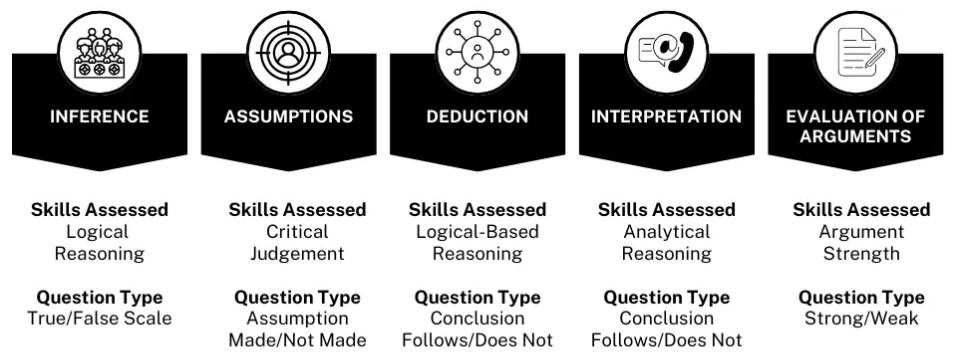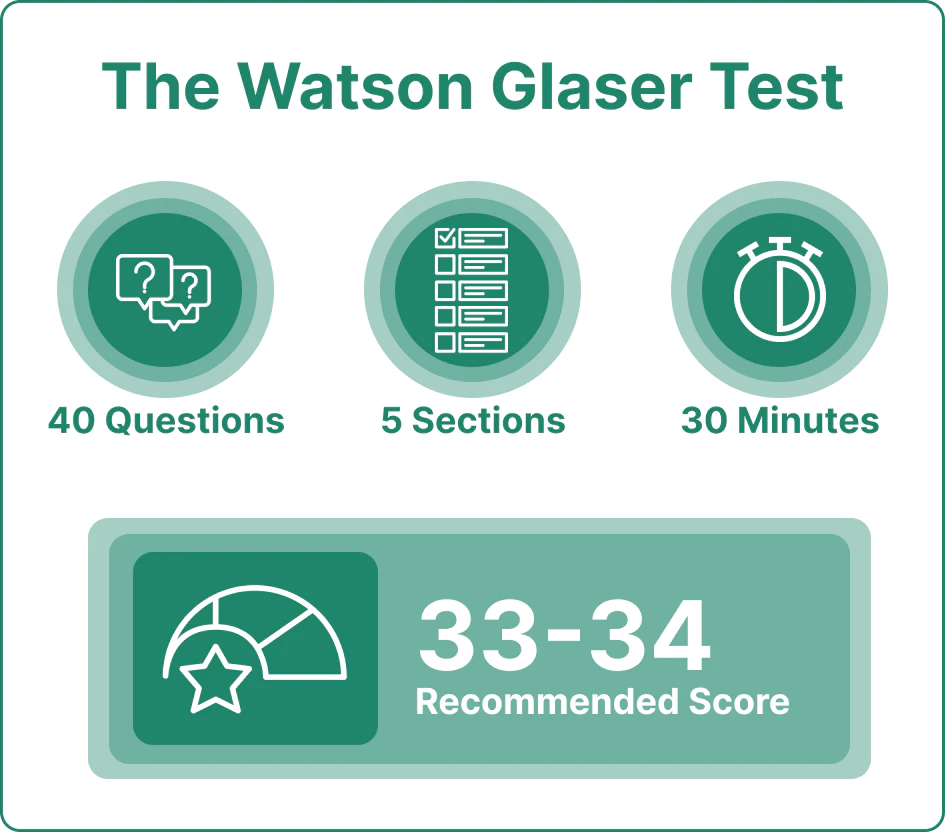Updated: October, 9, 2025
The Watson Glaser test assesses candidates’ critical thinking and reasoning skills. The Watson Glaser assessment is commonly employed to screen applicants for training contracts and vacation schemes, especially in law firms.
What Is the Watson Glaser Test?
The Watson Glaser test evaluates critical thinking and logical reasoning skills. It measures how effectively candidates can interpret information, identify assumptions, evaluate arguments, and draw sound conclusions. The assessment is widely used by law firms, government legal departments, and other professional organizations to assess candidates for training contracts, vacation schemes, and other analytical roles. Strong critical thinking is essential in fields where decisions must be based on complex information and logical analysis. The Watson Glaser test helps employers identify individuals who can reason clearly, assess evidence objectively, and make well-supported judgments.
Watson Glaser Test Overview
The structure of the Watson Glaser Critical Thinking Test is as follows, highlighting the key skills and question types assessed:
-
Inference: Drawing conclusions from observed or assumed facts.
-
Assumptions: Identifying whether an assumption is being made in the statement.
-
Deduction: Assessing whether conclusions logically follow from given premises.
-
Interpretation: Determining whether conclusions logically follow from the given information.
-
Evaluation of Arguments: Assessing whether an argument is strong or weak based on its relevance and importance to the question.

How the Watson Glaser Test Is Scored
The Watson-Glaser test is typically scored based on the number of correct answers out of 40. The raw score is converted into a percentile ranking that reflects how well the test taker performed compared to others who have taken the test.
-
Raw Score: The number of correct answers out of 40.
-
Percentile Rank: Your raw score is converted into a percentile, showing how you compare to other test-takers. For example:
-
33–34 correct answers = 80th percentile (strong score)
-
36–38 correct answers = 90th percentile (excellent score)
-
39–40 correct answers = 95th–99th percentile (top-tier score)
-

What Does the Watson Glaser Test Measure?
This test measures your critical thinking ability through several sections, including drawing conclusions, evaluation of arguments, and assumption recognition. This critical reasoning test includes typically a multiple-choice format, challenging test takers to use a creative and logical manner to navigate tricky questions and insufficient data.
The test often includes questions which push candidates to rely on structured logic rather than gut feeling. Scoring around 80% (about 33–34 correct answers) typically indicates strong critical thinking - placing you among the top performers sought by law firms and other analytical professions.
Who Uses the Watson Glaser Test?
The Watson Glaser test is generally used by law firms and government legal services. These include:
- Trainee Solicitors and Solicitors
- Graduate Trainees
- Lawyers
- Vacation Scheme
- Public Health Registrars
- Analysts
Critical thinking skills are crucial in all of the above, which is why companies use the WG in their recruitment process - to assess critical thinking accurately.
Here’s a list of some law firms that have been known to use the Watson Glaser Test as part of their recruitment process:
| Law Firm | Country/Region |
| United Kingdom | |
| Global | |
| Dentons | Global |
| Global | |
| Herbert Smith | Global |
| Hogan Lovells | Global |
| Global | |
| Norton Rose Fulbright | Global |
| United Kingdom |
Note: For different law firm pre-employment tests, check out our page on the Suited Assessment or visit our tailored preparation for Clifford Chance, Linklaters or other critical thinking tests.
How to Prepare for This Test
Methodical preparation is highly important as the Watson Glaser is known for its difficulty and focus on critical thinking. The test uses five strategies and question types, and success requires mastering all of them.
To achieve this, you should familiarize yourself with the question types, understand the rules for each section, and practice solving techniques and tips to ensure you're fully prepared.
Step 1: Understand the Test Format and Sections
The Watson Glaser test is made up of five sections that assess distinct aspects of critical thinking:
-
Inference
-
Recognition of assumptions
-
Deduction
-
Interpretation
-
Evaluation of arguments
Each section measures how you analyze information, assess logical connections, and distinguish sound reasoning from flawed arguments. Begin your preparation by learning what each of the five sections measures and how questions are structured, so you know exactly what skills to focus on.
Step 2: Practice Under Timed Conditions
The full test includes 40 multiple-choice questions to be completed in 30 minutes, meaning you have less than a minute per question.
To simulate real testing pressure:
-
Take timed practice sessions.
-
Track your pacing to ensure you can complete each section efficiently.
-
Review your mistakes immediately after finishing to identify patterns and weak areas.
Practicing with realistic simulations - including the sample questions below and our comprehensive Watson Glaser PrepPack - is the most effective way to build these skills and boost your performance.
Step 3: Strengthen Your Critical Thinking Skills
Beyond simple question drills, focus on strengthening your reasoning and comprehension skills:
-
Read complex texts (editorials, legal cases, reports) and identify main arguments.
-
Train yourself to separate facts from opinions.
-
Practice forming conclusions only when supported by clear evidence.
Step 4: Review Tips Before the Exam
-
Stay objective: Don’t rely on outside knowledge and use the information provided.
-
Read the questions carefully: Many questions hinge on precise wording.
-
Manage your time: Make sure to manage your time carefully, as the strict time limit is a key part of the challenge.
-
Check assumptions: Make sure each conclusion is logically supported by the text.
Watson Glaser Full Course PrepPack
- Real test simulations and expert solutions.
- Comprehensive strategies, tips, and interactive video guides
- Instant access for just £49.
★ 4.7 (190+ reviews) Don't just hope to pass - prepare to excel!
Test Question Examples
Practice more test questions
FAQs:
The Watson Glaser Critical Thinking Test is a pre-employment critical thinking test widely used by law firms, government legal services, and other employers in their recruitment process.
This test measures your critical thinking ability through several sections, including drawing conclusions, evaluation of arguments, and assumption recognition. This critical reasoning test includes typically a multiple-choice format, challenging test takers to use a creative and logical manner to navigate tricky questions and insufficient data.
Critical thinking skills are an important part of what companies aim to assess in their recruitment process since employees with strong critical thinking can make decisions with limited supervision, allowing them to make independent judgment decisions. Also, critical thinking skills help them solve problems, identify logical fallacies, build strategies, and make them better at their job in general.
- Trainee Solicitors and Solicitors
- Graduate Trainees
- Lawyers
- Vacation Scheme
- Public Health Registrars
- Analysts
Critical thinking skills are crucial in all of the above, which is why companies use the WG in their recruitment process - to assess critical thinking accurately.
The test is normally timed and allows you up to 30 minutes to complete all 40 questions. There are also untimed versions for candidates requiring adjustments. Note that every section is timed separately, 30 minutes is the total allotted time.
The Watson Glaser Critical Thinking Test is not an IQ test. Instead, it measures a candidate's critical thinking ability, a crucial skill directly related to making considered conclusions and counterintuitive solving methods.
Unlike general knowledge or IQ tests, the Watson Glaser critical thinking appraisal focuses on your ability to logically evaluate arguments, recognize assumptions, and make decisions based on information from given statements.
The test is an important part of challenging selection processes, especially in the legal sector, where critical thinking is essential.
Anything below the estimated 33-34 questions it takes to reach the top 80% will probably lead to you missing out on the position.




